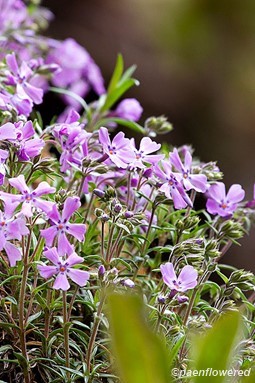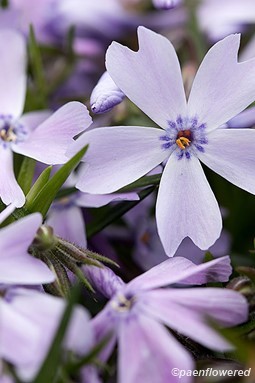Phlox subulata
Phlox subulata moss phlox
Moss phlox or creeping phlox is a native, evergreen to semi-evergreen perennial that is part of the phlox family. It forms low, mat-like ground cover up to 6 inches tall and spreads 2 to 3 feet wide, resembling moss. From April to May, fragrant tubular flowers with five notched lobes bloom in shades of pink, purple, and white, offering many pollinators like bees, butterflies, and hummingbirds a sweet treat of nectar and pollen.
The leaves are needlelike, linear to awl-shaped, and arranged in dense, opposite pairs along the stems. They are evergreen to semi-evergreen, with entire (toothless) margins, and are typically stalkless or clasping. Their sharp tips and compact tufts give the plant its moss-like texture.
Moss phlox thrives in full sun, though it tolerates partial shade in hot, humid climates. It prefers well-drained, sandy or rocky soils that are slightly acidic to neutral in pH, but it can adapt to dry and hot environments once established. Native to the central and eastern regions of Canada and the United States, including most of Pennsylvania, it thrives on dry slopes, rocky barrens, and open woodlands, especially in the Appalachian Mountains.
Habitat & Range
Occasional in serpentine barrens and on dry, rocky slopes. Prefer full sun and well-drained, sandy or rocky soils.
Present throughout the state except north-west.
Range: Native to the central and eastern regions of Canada and the United States.
Wetland code: Not classified
Phenology
Flowers April to June. Blooming period is 3 to 4 weeks.
Characteristics
Inflorescence loose cymes of 2 to 8 flowers, at tips of stems
Flowers corolla deep pink to violet or white; 5 flat, petal-like notched lobes extending from corolla tube; 5 green to brown sepals, 5 stamens; ¾″ across
Leaves small, stiff (needle-like), tufted, evergreen to semi-evergreen; linear to awl-shaped; opposite, entire; up to 1″ long
Stem light green to reddish purple; sprawling, terete, pubescent
Fruit dry 3-valved capsule with 1 to 4 (most often 3) seeds per locule; self-seeding
Height 4 to 6 inches; spread 2 to 3 feet
Plant Codes
S-rank: S5 (Secure)
G-rank: G5 (Secure)
Ecology
Main pollinators are bees while butterflies and hummingbirds are frequent nectar visitors. Foliage, flowers and seeds are occasionally browsed by small mammals such as rabbits and voles, and targeted by sap-feeding insects including aphids and phlox plant bugs.






Comments
Have you spotted this plant in your area? We'd love to hear about your experience! Share your comments or questions about the plant below. Comments are moderated before posting.